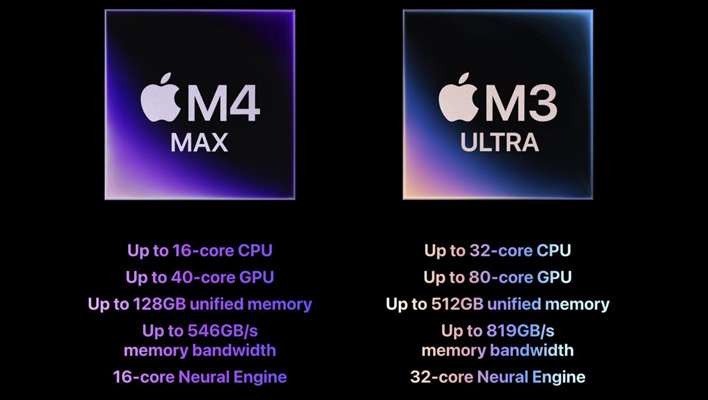After rolling out a couple of
new iPad tablets yesterday (iPad Air with M3 and a new entry-level iPad with an A16 Bionic), Apple today followed suit with some more (and bigger) announcements, including a new MacBook Air powered by its M4 silicon, a retooled Mac Studio, and its most performant chip to date, the new M3 Ultra with twice the Neural Engine cores and other hefty upgrades.
It can be a little confusing parsing Apple's in-house silicon designs based on name alone. In this case, you might think that the 'M3' designation in the M3 Ultra denotes a less performant part than its M4 lineup, but that's not the case. The reason is because it's a monster chip that links a pair of M3 dies via Apple's UltraFusion packaging architecture, with over 10,000 high-speed connections for big bandwidth and low latency.
"This allows the system to treat the combined dies as a single, unified chip for massive performance while maintaining Apple’s industry-leading power efficiency. UltraFusion brings together a total of 184 billion transistors to take the industry-leading capabilities of the new Mac Studio to new heights," Apple explains.
According to Apple, the M3 Ultra represents the pinnacle its scalable system-on-a-chip architecture and it takes aim at users who need more silicon muscle for heavily threaded and bandwidth-intensive applications.
The M3 Ultra provides all that with up to 32 CPU cores, including 24 performance cores and 8 efficiency cores, for a claimed 1.5X performance uplift versus the M2 Ultra, and 1.8X versus the M1 Ultra. Additionally, Apple says the M3 Ultra boasts the largest GPU in any of its in-house designed silicon, which translates to up to 80 graphics cores for double the graphics performance of the M2 Ultra and a 2.6X graphics uplift compared to the M1 Ultra.
Beyond the raw specs, the M3 Ultra's graphics architecture enables things like dynamic caching, hardware-accelerated mesh shading, and ray tracing support, all of which can benefit creators and gamers alike. And of course.
Of course, this wouldn't be a product announcement with a pitch for Apple Intelligence.
"A powerful 32-core Neural Engine fuels AI and machine learning (ML), and powers Apple Intelligence, the personal intelligence system that puts powerful generative models right at the core of the new Mac Studio. In fact, M3 Ultra is built for AI, including ML accelerators in the CPU, Apple’s most powerful GPU, the Neural Engine, and over 800GB/s of memory bandwidth," Apple says.
According to Apple, the M3 Ultra in the Mac Studio has the chops to run on-device (read: not outsourced to the cloud) large language models (LLMs) with over 600 billion parameters.
The other big highlight here is a massive amount of unified memory, which is important given that the chip is handling both compute and graphics. M3 Ultra's high-bandwidth, low-latency memory starts at 96GB and can scale up to 512GB (half a terabyte).
How does all this compare to the M4 Max? Here are some highlights...
- M3 Ultra CPU Cores: Up to 32
- M4 Max CPU Cores: Up to 16
- M3 Ultra GPU Cores: Up to 80
- M4 Max GPU Cores: Up to 40
- M3 Ultra Neural Engine: Up to 32 cores
- M4 Max Neural Engine: Up to 16 cores
- M3 Ultra Unified Memory: Up to 512GB and 819GB/s of bandwidth
- M4 Max Unified Memory: Up to 128GB and 546GB/s of bandwidth
The M3 Ultra is the burlier chip across the board, because again, it's basically two chips fused into one package. It's basically like having dual M4 Max chips, but recognized as a single chip.
Apple's new
M3 Ultra is available now, starting with its refreshed Mac Studio.



